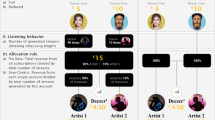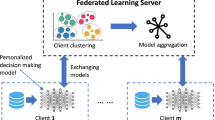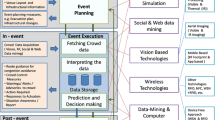Abstract
Mobile CrowdSensing(MCS) is a new type of network which needs a large number of users to collect data to complete the sensing task and requires users to have a high level of participation. In the current research, the incentive purpose is mainly achieved by paying certain rewards to service providers. However, due to the demand for data quality and quantity, platforms often have high consumption. Most of the current studies assume that the evaluation of an item by a node is not affected by its ownership status. But behavioral economics points out that because of the existence of endowment effect, the evaluation of the value of an item by a node is greater when it is owned than when it is not owned, thereby affecting the value evaluation strategy of the node. Therefore, inspired by the phenomenon that enterprises use share dividends to stimulate endowment effect of employees in daily life and thus motivate employees to maintain loyalty, the paper constructs a mapping relationship between it and MCS and designs a Reverse Combinatorial Auction Based Endowment Effect (RCBEE) incentive mechanism. The paper designs endowment assets and assigns them to selected nodes according to the relationship between multiple coefficients of nodes, so as to introduce the endowment effect. The paper analyzes the change of the node on the evaluation value of endowment assets, changes the node income, and reconstructs the income matrix. On the one hand, the RCBEE mechanism continuously strengthens the node’s endowment intensity by setting the holding period; on the other hand, it introduces the contribution threshold to trigger the node’s endowment effect, so that users can maximize the incentive goal of social welfare by reducing the bid price or completing more tasks. Simulation experiments show that, compared with the traditional incentive mechanism, RCBEE reduces the payment cost and increases the social welfare.









Similar content being viewed by others
References
Capponi A, Fiandrino C, Kantarci B, Foschini L, Bouvry P (2019) A survey on mobile crowdsensing systems: challenges, solutions and opportunities. IEEE Commun Surveys Tutor 21(3):2419–2465
Jin H, Su L, Nahrstedt K (2017) Centurion: Incentivizing multi-requester mobile crowd sensing, in IEEE INFOCOM 2017 - IEEE Conference on Computer Communications, pp 1–9
Ji G, Yao Z, Zhang B, Li C (2020) A reverse auction-based incentive mechanism for mobile crowdsensing. IEEE Internet Things J 7(9):8238–8248
Tong LA, Zhu YB, Huang LB (2019) Tgba: A two-phase group buying based auction mechanism for recruiting workers in mobile crowd sensing. Comput Netw 149:56–75
Gendy ME, Al-Kabbany A, Badran EF (2019) Maximizing clearance rate of reputation-aware auctions in mobile crowdsensing,“in 2019 16th IEEE Annual Consumer Communications Networking Conference (CCNC), pp. 1–2
Jin H, Su L, Chen D, Guo H, Nahrstedt K, Xu J (2019) Thanos: incentive mechanism with quality awareness for mobile crowd sensing. IEEE Trans Mob Comput 18(8):1951–1964
Zhang X, Yang Z, Sun W, Liu Y, Tang S, Xing K, Mao X (2017) Incentives for mobile crowd sensing: a survey. IEEE Commun Surveys Tutor 18(1):54–67
Luo T, Tan H-P, Xia L (2014) Profit-maximizing incentive for participatory sensing,” in IEEE INFOCOM 2014 - IEEE Conference on Computer Communications, pp. 127–135
Huang H, Xin Y, Sun Y, Yang W (2017) A truthful double auction mechanism for crowdsensing systems with max-min fairness,” in 2017 IEEE Wireless Communications and Networking Conference (WCNC), pp. 1–6
Zhang X, Gao L, Cao B, Li Z, Wang M (2017) A double auction mechanism for mobile crowd sensing with data reuse,“in GLOBECOM 2017–2017 IEEE Global Commun Conference, pp 1–6
Li T, Jung T, Qiu Z, Li H, Cao L, Wang Y (2020) Scalable privacy-preserving participant selection for mobile crowdsensing systems: participant grouping and secure group bidding. IEEE Trans Network Sci Eng 7(2):855–868
Nie J, Luo J, Xiong Z, Niyato D, Wang P (2019) A stackelberg game approach toward socially-aware incentive mechanisms for mobile crowdsensing. IEEE Trans Wirel Commun 18(1):724–738
Wang Z, Zhou H, Zhao Y, Wu Y, Deng S, Huang H (2019) Stackelberg game based dynamic admission and scheduling in mobile crowdsensing. IEEE Access 7:101689–101703
Hao L, Jia B, Liu J, Huang B, Li W (2020) Vcg-qcp: A reverse pricing mechanism based on vcg and quality all-pay for collaborative crowdsourcing,” in 2020 IEEE Wire-less Communications and Networking Conference (WCNC), pp. 1–6
Li Q, Cao H, Wang S, Zhao X (2020) A reputation-based multi-user task selection incentive mechanism for crowdsensing. IEEE Access 99:1–1
Valerio L, Bruno R, Passarella A (2015) Cellular traffic offloading via opportunistic networking with reinforcement learning. Comput Commun 71:129–141
Mao G, Zhang Z, Anderson BDO (2016) Cooperative content dissemination and offloading in heterogeneous mobile networks. IEEE Trans Veh Technol 65(8):6573–6587
“Medwatcher.” http://www.fda.gov/MedicalDevices/Safety/portaProblem/ucm385880.htm
Cheng Y, Li X, Li Z, Jiang S, Li Y, Jia J, Jiang X (2014) Aircloud: a cloud-based air-quality monitoring system for everyone,” in Proceedings of the 12th ACM Conference on embedded network sensor systems, pp. 251–265
Zhao B, Tang S, Liu X, Zhang X (2020) Pace: Privacy-preserving and quality-aware incentive mechanism for mobile crowdsensing,” IEEE Transactions on Mobile Computing, vol. PP, no. 99, pp. 1–1
Restuccia F, Ferraro P, Sanders TS, Silvestri S, Das SK, Lo Re G (2019) First: a framework for optimizing information quality in mobile crowdsensing systems. Acm Trans Sens Networks 15(1):5.1–5.35
He S, Shin D, Zhang J, Chen J (2017) Near-optimal allocation algorithms for location-dependent tasks in crowdsensing. IEEE Trans Veh Technol 66(4):3392–3405
Gong W, Zhang B, Li C (2019) Location-based online task assignment and path planning for mobile crowdsensing. IEEE Trans Veh Technol 68(2):1772–1783
Depoorter B , Hoeppner S (2014) Endowment Effect[J]. Encyclopedia of Law & Economics, pp. 1–9
Horowitz JK, McConnell KE (2002) A review of wta/wtp studies. J Environ Econ Manag 44(3):426–447
Cell TT, Hammitt JK (2014) A new meta-analysis on the wtp/wta disparity. J Environ Econ Manag 68(1):175–187
Shafer GR (1984) Judgment under uncertainty: Heuristics and biases. J Am Statistic Assoc 79(385):223–224
Thaler RH (1999) Mental accounting matters. J Behav Decis Mak 12(3):183–206
Morewedge CK, Giblin CE (2015) Explanations of the endowment effect: an integra-tive review. Trends Cognitive Ences 19(6):339–348
Ariely D, Huber J, Wertenbroch K (2018) When do losses loom larger than gains? J Market Res 42(2):134–138 2005
Peters E, Slovic P, Gregory R (2003) The role of affect in the wta/wtp disparity. J Behav Decis Mak 16(4):309–330
Zhang Y, Fishbach A (2005) The role of anticipated emotions in the endowment effect. J Consum Psychol 15(4):316–324
Bolton GE, Ockenfels A (1998) Strategy and equity: an erc-analysis of the güth–van Damme game. J Math Psychol 42(2–3):215–226
Murata A, Matsushita Y, Kubo S, Moriwaka M (2014) Analysis of human behavior by experimental game-theoretic approach-cooperative behavior, risk averse and seeking tendencies, and risk diversification,” in 2014 Proceedings of the SICE Annual Conference (SICE), pp. 947–954
Kahneman D, Knetsch JL, Thaler RH (1990) Experimental tests of the endowment effect and the coase theorem. J Polit Econ 98(6):1325–1348
Li D, Qiu L, Liu J, Xiao C (2018) Analysis of behavioral economics in crowdsensing: a loss aversion cooperation model. Sci Program 2018:1–18
Jaimes LG, Calderon JM (2018) Gaussian mixture model for crowdsensing incentivization,” in 2018 IEEE 8th Annual Computing and Communication Workshop and Conference (CCWC), pp. 685–689
Rui S and Yong Z (2017) Modelling and simulation for rumor propagation on complex networks with repast simulation platform,“in 2017 4th International Conference on Information Science and Control Engineering (ICISCE), pp. 1014–1018
Author information
Authors and Affiliations
Corresponding author
Additional information
Publisher’s note
Springer Nature remains neutral with regard to jurisdictional claims in published maps and institutional affiliations.
This article is part of the Topical Collection: Special Issue on Convergence of Edge Computing and Next Generation Networking
Guest Editors: Deze Zeng, Geyong Min, Qiang He, and Song Guo
Rights and permissions
About this article
Cite this article
Liu, J., Huang, S., Wang, W. et al. An incentive mechanism based on endowment effect facing social welfare in Crowdsensing. Peer-to-Peer Netw. Appl. 14, 3929–3945 (2021). https://doi.org/10.1007/s12083-021-01142-1
Received:
Accepted:
Published:
Issue Date:
DOI: https://doi.org/10.1007/s12083-021-01142-1




